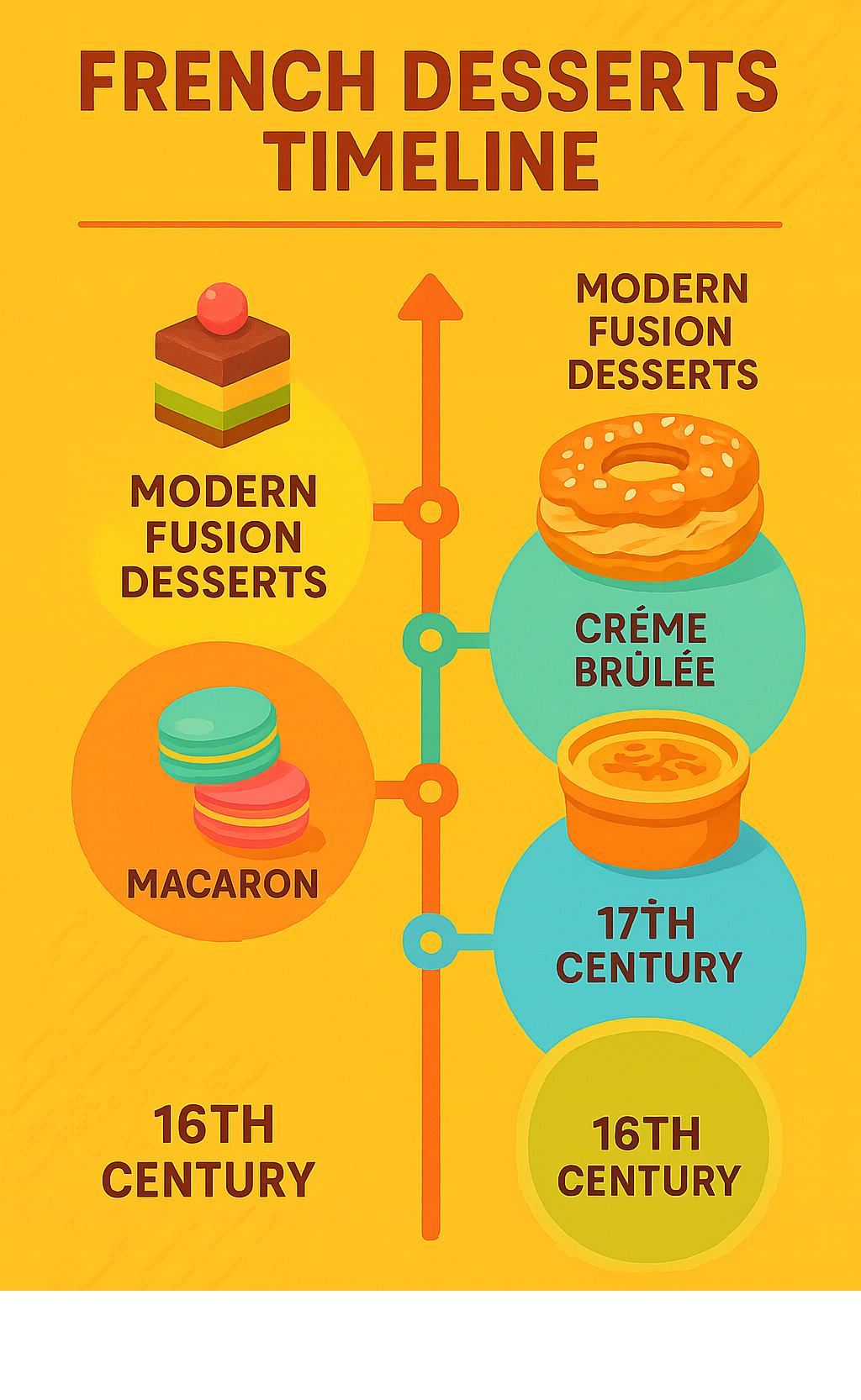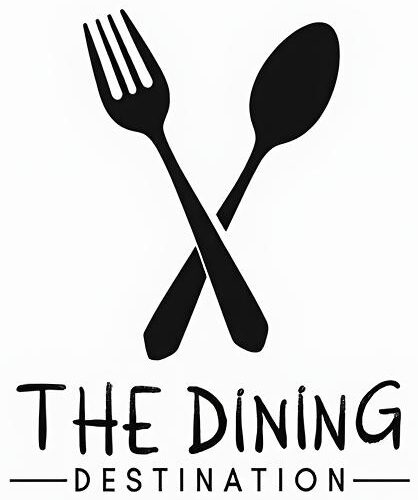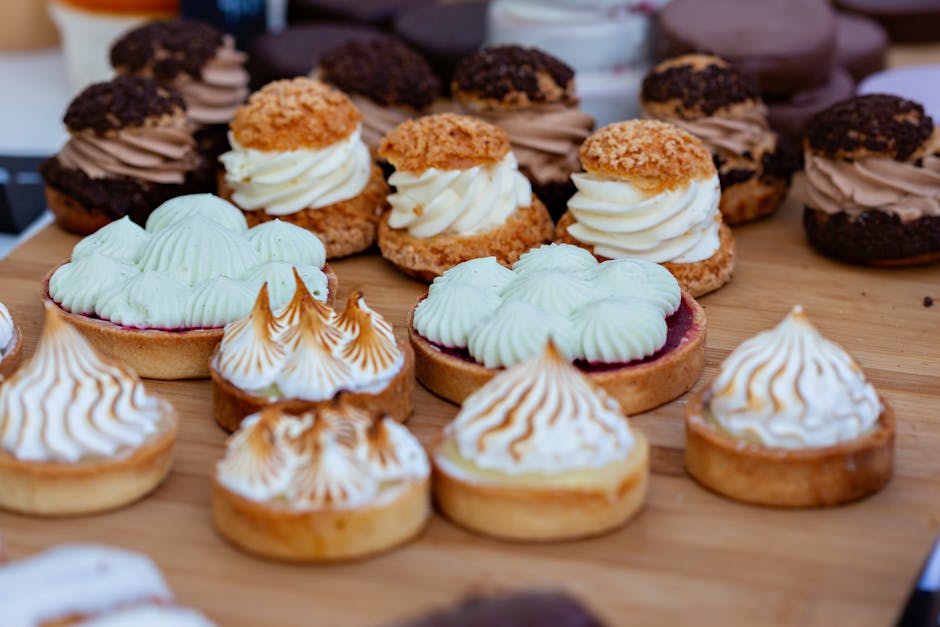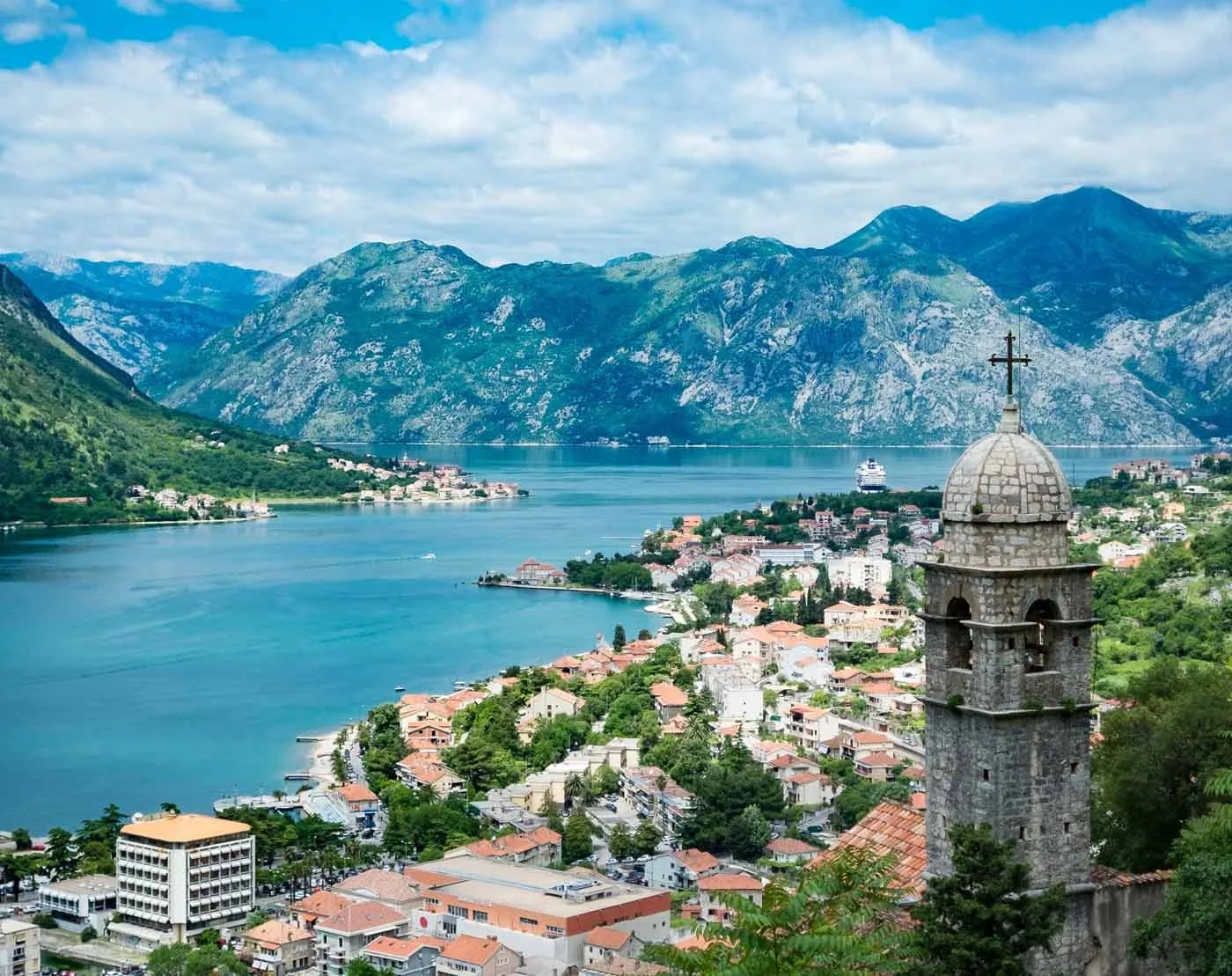The Sweet Heritage of France
French desserts represent the pinnacle of culinary artistry, combining centuries of tradition with exquisite technique. If you’re looking for the most iconic French desserts, here are the top 10 you should know:
- Crème Brûlée – Custard with caramelized sugar top
- Macaron – Meringue sandwich cookies with filling
- Éclair – Choux pastry filled with cream, topped with icing
- Tarte Tatin – Upside-down caramelized apple tart
- Mille-Feuille – Layered puff pastry with pastry cream
- Madeleine – Shell-shaped sponge cake
- Soufflé – Light, airy baked dish that rises
- Clafoutis – Fruit baked in custard-like batter
- Paris-Brest – Ring-shaped choux pastry with praline cream
- Canelé – Small caramelized pastry with custard center
France is home to more than 2,000 types of traditional desserts and pastries, each telling a story of regional heritage and culinary innovation. From the simple elegance of a perfect crème brûlée to the architectural marvel of a croquembouche, these sweet creations showcase the French dedication to precision, quality ingredients, and visual beauty.
“French desserts have a high ‘ooh la la’ factor—they’re stunning to look at and bring just the right combinations of flavor and texture,” as noted by pastry experts. This perfect balance is why they’ve captured imaginations worldwide.
The French pastry industry employs more than 54,000 professional pâtissiers across the country, maintaining standards that have been refined since the royal courts of the 17th century. Many iconic desserts have fascinating origin stories—like the Tarte Tatin, accidentally created upside-down in the 1880s by the Tatin sisters, or the Paris-Brest, designed in 1891 to honor a bicycle race with its wheel-shaped form.

What Makes French Desserts Unique
Have you ever wondered why French desserts seem to have that certain je ne sais quoi? It’s not just imagination – there really is something special about them that sets them apart from sweet treats around the world.
The Technique Factor
When it comes to French desserts, precision isn’t just preferred – it’s essential. Unlike the “pinch of this, dash of that” approach many of us use at home, French pastry demands exactness. That’s why French recipes typically list ingredients by weight rather than volume – because every gram matters!
French pastry chefs think of desserts as architectural projects. Each component is crafted separately with specific techniques before being assembled into the final masterpiece.
The Ingredient Advantage
French butter deserves special mention – with its higher fat content (at least 82% compared to the American standard of 80%), it creates pastries with incomparable richness and flavor. The concept of terroir – how environmental factors affect food quality – isn’t just for wine in France. It extends to the cream, butter, fruits, and other ingredients that make their desserts truly exceptional.
French pastry follows nature’s calendar. While butter and chocolate feature year-round, many classics showcase whatever’s in season – from summer’s juicy cherry clafoutis to autumn’s caramelized apple tarte Tatin.
The Professional Hierarchy
Becoming a pâtissier in France requires years of rigorous training within the brigade de cuisine – the traditional kitchen hierarchy where pastry chefs hold a specialized, respected position. This professional dedication has maintained exacting standards across generations.
As renowned Maestro Iginio Massari puts it, “Pastry is the art of temptation and seduction.” This philosophical approach reflects how French pastry chefs view their craft – not merely as making sweet food but creating moments of pleasure and beauty.
The Balance of Complexity and Simplicity
What’s fascinating about French desserts is their range. On one end, you have the croquembouche – a towering cone of cream puffs that showcases technical virtuosity. On the other, there are humble madeleines or rustic clafoutis that celebrate simplicity and quality ingredients.
What unites this diverse sweet universe is balance. French desserts rarely hit you over the head with sweetness. Instead, they offer complex flavor profiles where sweet is just one note in a sophisticated composition that might include bitter, acidic, floral, or nutty elements.
| French Dessert Hallmarks | Italian Dessert Hallmarks |
|---|---|
| Butter-forward recipes | Olive oil-based traditions |
| Precise technique emphasis | Regional variation emphasis |
| Elaborate presentation | Rustic presentation |
| Cream and custard foundations | Cheese and nut foundations |
| Subtle, balanced sweetness | Bold, pronounced flavors |
Ultimate List of Classic French Desserts — The Heart of French Desserts
Let’s explore the most beloved French desserts that have captured hearts worldwide. These sweet masterpieces aren’t just treats – they’re cultural treasures with fascinating stories behind them.
Crème Brûlée
There’s something magical about cracking through that glassy caramelized sugar top to reach the silky custard beneath. This beloved Normandy creation dates back to the 17th century and appears on more than 80% of French restaurant dessert menus. The contrast between warm, crisp caramel and cool, velvety custard creates a sensory experience that’s simply irresistible.
Macaron
Those colorful little sandwich cookies you see in neat pastry shop windows are a world away from coconut macaroons. True French macarons feature delicate almond flour meringue shells embracing ganache, buttercream, or jam. While chocolate and pistachio remain classics, creative pâtissiers now offer everything from rose to salted caramel.
Éclair
When a pastry is named after lightning (“éclair” in French), you know it won’t stick around your plate for long! These oblong choux pastry delights filled with pastry cream and topped with glossy fondant disappear in a flash. The chocolate version reigns supreme, though coffee and vanilla varieties hold their own in the pastry case.
Tarte Tatin
Some of the best culinary creations come from happy accidents, and this upside-down caramelized apple tart is proof. Back in the 1880s, one of the Tatin sisters reportedly forgot to add a crust to her apple tart and improvised by placing it on top. The result? A masterpiece of deeply caramelized apples atop crisp pastry that’s now a national treasure.
Mille-Feuille
The name means “thousand leaves,” and one bite explains why. Those seemingly endless layers of puff pastry alternating with luscious pastry cream create a textural symphony. Also known as Napoleon, this dessert typically sports a distinctive patterned fondant topping.

Madeleine
These humble shell-shaped sponge cakes achieved literary immortality thanks to Marcel Proust’s novel “In Search of Lost Time,” where a madeleine dipped in tea releases a flood of childhood memories. Traditionally scented with lemon zest and vanilla, these buttery treats require their distinctive shell-shaped pans to achieve that iconic form.
Clafoutis
When cherries are in season in the Limousin region, locals celebrate with this rustic dessert – fruit baked in a flan-like batter until just set. Traditionalists leave the cherry pits in, as they impart an almond-like flavor during baking. Modern versions often remove the pits for convenience and experiment with other seasonal fruits.
Canelé
These little fluted treasures from Bordeaux pack an incredible flavor punch with their caramelized crusts and custardy, rum-infused centers. The traditional copper molds are coated with beeswax to achieve that perfect exterior. The Brotherhood of the Canelé formed in the 1980s to protect the authentic recipe, even standardizing the spelling.
Paris-Brest
This dessert has a sporty origin story – it was created in 1891 to commemorate the Paris-Brest-Paris bicycle race. The ring-shaped choux pastry filled with praline-flavored cream cleverly mimics a bicycle wheel, while sliced almonds add decorative flair and textural contrast.
Pastries: The Pillars of French Desserts
Step into any French pâtisserie and you’ll immediately understand why these buttery, flaky creations form the backbone of French desserts. These aren’t just treats—they’re edible art that showcases generations of technical mastery and cultural heritage.
Croissant
That distinctive crescent shape with a honeycomb interior has become France’s most recognized culinary ambassador. What makes a truly authentic croissant special isn’t just its shape, but the dozens of alternating butter and dough layers created through the painstaking lamination process. Many French purists still prefer theirs plain—letting the butter-rich layers speak for themselves with a simple café au lait for dunking.
Pâte Feuilletée (Puff Pastry)
Behind many of France’s most beloved desserts lies this magical dough that transforms into hundreds of crisp, delicate layers. The technique demands patience—fold, roll, chill, repeat—creating the foundation for everything from golden palmiers to the neat mille-feuille. Making pâte feuilletée from scratch is something of a rite of passage for serious home bakers.
Choux Pastry Creations
There’s something almost magical about choux pastry. This humble mixture—cooked first on the stovetop before baking—undergoes a dramatic change in the oven, puffing up to create hollow centers perfect for luscious fillings. From the oblong éclair to the round profiterole, choux is versatility personified.
Perhaps the most spectacular expression of choux is the croquembouche—that towering cone of cream-filled puffs bound with threads of caramel that graces French celebrations.
Kouign-Amann
This Breton treasure might just be butter’s greatest achievement. Unlike other laminated pastries, kouign-amann (pronounced “queen ah-mahn”) incorporates sugar directly between its layers, creating a pastry that’s simultaneously caramelized and crunchy outside while remaining tender and moist within.
Paris-Brest
Beyond its charming bicycle-wheel shape (created to honor the famous Paris-to-Brest bicycle race), this choux pastry ring showcases the sophisticated flavor balance that defines French desserts. The praline mousseline filling creates a nutty complexity that’s never cloyingly sweet.

At The Dining Destination, we’ve found that understanding these foundational French pastries opens a window into the soul of French culinary philosophy—where technique isn’t just about showing off, but about changing simple ingredients into something transcendent.
Want to explore how these French techniques have traveled and transformed across cultures? Dive deeper with our World Cuisine Exploration section, where we trace the global journey of these delicious traditions.
Custards & Creams: Silky Side of French Desserts
There’s something almost magical about the way French chefs transform humble ingredients into silken wonders. The world of French desserts wouldn’t be complete without their legendary custards and creams – those luscious, spoon-worthy creations that showcase the French knack for turning simplicity into pure luxury.
Crème Brûlée
Ask anyone to name a French custard, and crème brûlée likely springs to mind first. This beloved dessert is a study in delightful contrasts – the brittle caramelized sugar top giving way to the velvety vanilla-scented custard beneath. That satisfying “crack” when your spoon breaks through the sugar crust is one of dessert’s most treasured moments.
“Crème brûlée is essentially the perfect love letter,” pastry chef Andrew Zimmern once remarked. The custard itself remains unchanged – rich with egg yolks and cream, delicately perfumed with real vanilla bean.
Pot de Crème
If crème brûlée is a love letter, then pot de crème is a whispered secret. These little porcelain pots hold custard at its most intense – denser and more velvety than its caramelized cousin. The name literally means “pot of cream,” referencing the traditional lidded vessels they’re served in.
What makes pot de crème special is its adaptability. While chocolate versions might be most familiar, French chefs craft them in countless flavors – coffee, pistachio, maple, or seasonal fruit.
Île Flottante (Floating Island)
There’s something undeniably playful about île flottante. This whimsical creation features pillowy islands of poached meringue adrift on a sea of crème anglaise (vanilla custard sauce). Often drizzled with caramel and scattered with toasted almonds, it’s a dessert that makes people smile before they’ve taken a single bite.
Crème Caramel
Known internationally as flan, crème caramel flips the script on crème brûlée. Here, the caramel goes in first, lining the bottom of the dish before the custard mixture is added. During baking, the caramel softens into a sauce that, when unmolded, cascades over the set custard like liquid gold.
The science behind these custards reveals why French pastry chefs undergo such rigorous training. According to scientific research on custard chemistry, egg proteins begin coagulating at precisely 70°C (158°F), requiring careful temperature control to achieve that perfect silken set without curdling.
At The Dining Destination, we’ve found that mastering even one classic French custard can transform a home cook’s repertoire. The techniques learned – tempering eggs, managing water baths, achieving that perfect consistency – become culinary skills that extend far beyond dessert making.
Cakes & Tarts That Wow
When it comes to French desserts, their cakes and tarts are like edible works of art that make your jaw drop before you even take the first bite. Unlike their sweeter, denser American cousins, French gâteaux (cakes) tend to be lighter affairs with complex flavors and stunning presentations.
Opera Cake
The Opera cake is like the sophisticated symphony of the pastry world – precise, harmonious, and unforgettable. This neat rectangular creation features thin layers of almond sponge delicately soaked in coffee syrup, alternating with velvety coffee buttercream and silky chocolate ganache, all crowned with a glossy chocolate glaze. Born in the 1950s with clean, modernist lines, each slice reveals perfect, even layers that showcase the architectural precision French pastry chefs are famous for.
Fraisier
Imagine spring captured in cake form – that’s the Fraisier. This stunning celebration of strawberry season features a light genoise sponge embracing a luscious mousseline cream (pastry cream lightened with butter) and fresh strawberries cleverly arranged around the perimeter so they create a beautiful red border visible from the outside. Topped with a thin layer of marzipan, the Fraisier perfectly demonstrates how French desserts lift seasonal fruits to star status.
Tarte Tatin
The accidental masterpiece! Beyond its charming origin story of distracted sisters and an upside-down mistake, the Tarte Tatin represents French culinary genius at its most approachable. The slow caramelization of apples transforms them into something almost magical – tender, deeply flavored, and glistening with amber syrup. The contrast between these luxurious apples and the crisp pastry underneath creates a textural symphony that’s impossible to resist.

Tarte Normande
The apple-loving region of Normandy gives us this wonderful tart that combines crisp apples with a rich, custardy filling, sometimes improved with a splash of the region’s famous Calvados apple brandy. Unlike its upside-down cousin the Tarte Tatin, the Normande is baked right-side up in a traditional tart pan with a removable bottom.
What makes French tarts so special is their restraint. They typically feature shorter sides than American pies, more delicate crusts, and fillings that prioritize natural flavors over excessive sweetness. The French approach emphasizes precision – those perfectly crimped edges and evenly arranged fruit slices aren’t just for show; they ensure even baking and consistent texture in every bite.
At The Dining Destination, we’ve noticed how French tarts often reflect the changing seasons – from summer’s vibrant berry tarts to autumn’s warming pear and almond creations. These desserts are like edible calendars, celebrating what’s fresh and perfect at that moment.
Regional Gems Worth the Trip
There’s something magical about tasting a dessert in the very place it was born. Across France’s diverse landscapes, French desserts tell stories of local traditions, seasonal ingredients, and centuries of culinary wisdom.
Canelé de Bordeaux
In the wine-soaked streets of Bordeaux, you’ll find these distinctive fluted treasures with their dramatically contrasting textures. Bite through the deeply caramelized, almost crunchy exterior and you’ll find a custardy center perfumed with vanilla and rum.
The traditional copper molds, lovingly coated with beeswax before each use, are part of what gives canelés their signature appearance. This isn’t just baking—it’s ritual. When the Brotherhood of the Canelé formed in the 1980s, they took their mission seriously: standardizing both the recipe and even dropping one ‘n’ from the original “cannelé” spelling.
Far Breton
Travel northwest to the rugged coastline of Brittany and you’ll encounter the Far Breton, a dessert as straightforward and honest as the region itself. This dense, pudding-like cake studded with rum-soaked prunes feels both homey and special.
What makes a truly authentic Far Breton? Patience. The batter needs at least four hours (preferably overnight) to rest before baking, allowing the flour to fully hydrate and creating that distinctive dense-yet-tender texture.
Clafoutis Limousin
In the central Limousin region, cherry trees inspired one of France’s most beloved rustic desserts. A proper clafoutis from this region comes with a charming warning: watch out for cherry pits! Traditionally, the cherries are left unpitted because those little kernels release benzaldehyde during baking, infusing the custardy batter with subtle almond notes.
Calisson d’Aix
Journey to sun-drenched Provence and you’ll find these delicate, almond-shaped confections that taste like bottled sunshine. Calissons combine a paste of ground almonds with candied fruits—typically melon and orange peel—finished with a thin layer of royal icing. Dating back to the 15th century, these treats have become synonymous with Christmas celebrations in Aix-en-Provence.
At The Dining Destination, we believe these regional specialties offer more than just delicious flavors—they provide windows into France’s diverse cultural heritage. There’s something profound about tasting a dessert in its birthplace, where the climate, ingredients, and traditions all contributed to its creation.
For more extraordinary food experiences around the world, including deeper dives into regional French specialties, explore our Best Culinary Experiences guide.
Regional Sweet Specialties Map of France
If you’re planning a sweet tour of France, you’ll find that French desserts aren’t just delicious—they’re a delicious geography lesson! Each region proudly crafts distinctive treats that tell stories of local ingredients, cultural influences, and centuries of tradition.
Normandy & Brittany: The Butter Belt
In Normandy, apples reign supreme. This apple-growing powerhouse transforms its harvest into heavenly Tarte Normande and rustic apple tarts, often spiked with a splash of Calvados (the region’s famed apple brandy).
Meanwhile, Brittany celebrates butter like nowhere else. The gloriously decadent kouign-amann (which literally means “butter cake” in the Breton language) features layer upon layer of caramelized, buttery goodness. Don’t miss Brittany’s salted butter caramels—these chewy treasures honor the region’s centuries-old salt harvesting traditions along the coast.
Bordeaux & Southwest: Wine Country Sweets
Bordeaux gave the world the canelé—those small, fluted pastries with a caramelized crust and custardy interior infused with rum and vanilla. There’s a charming story behind them: nuns reportedly created these treats using leftover egg yolks from winemakers, who used the whites to clarify their wines.
In the Basque Country, the gâteau Basque steals hearts with its tender cookie-like dough filled with either black cherry jam or velvety pastry cream. Look for the traditional Basque cross pattern marked on top—a proud symbol of regional identity.
Alsace: Germanic Influences
The kougelhopf is Alsace’s crown jewel—a ring-shaped, brioche-like cake studded with raisins and almonds. Its distinctive shape comes from special ceramic molds passed down through generations of families.
While pain d’épices (spice bread) is enjoyed throughout France, the Alsatian version stands apart with its distinctive honey-forward flavor profile, often incorporating honey from local beekeepers and a unique blend of warming spices.
Central & Limousin: Fruit Forward
Limousin proudly claims the cherry clafoutis as its own. This rustic dessert makes spectacular use of the region’s cherry harvest, traditionally leaving the pits in for that subtle almond flavor they impart during baking.
The Berry Region in the Loire Valley gave us the legendary tarte Tatin, born in the town of Lamotte-Beuvron. This “upside-down” caramelized apple tart was supposedly created by accident but became one of France’s most beloved desserts.

Modern Trends & Home-Baking Tips
The world of French desserts is constantly evolving, blending centuries-old techniques with fresh innovations. Today’s French pastry scene is as exciting as ever, with professional pâtissiers pushing boundaries while home bakers worldwide are mastering these once-intimidating treats in their own kitchens.
Contemporary French Pastry Innovations
Walk into a modern Parisian pâtisserie and you’ll notice how tradition and innovation dance together beautifully. Today’s French pastry chefs honor their heritage while embracing new ideas:
“I’m seeing French pastry becoming more playful and experimental, but never at the expense of technique,” shares Chef Marie Dubois, who studied at Le Cordon Bleu. “The foundations remain sacred.”
Global flavors have found their way into classic forms – imagine biting into a yuzu-infused Paris-Brest or a matcha éclair. Many chefs are also creating desserts with reduced sugar content, allowing the natural flavors of high-quality ingredients to shine through.
Sustainability has become a priority as well. Leading pâtisseries now emphasize seasonal ingredients and creative approaches to reducing waste.
Essential Equipment for French Pastry at Home
You don’t need a professional kitchen to create wonderful French desserts, but a few key tools will make your journey much smoother:
A good kitchen scale is perhaps the most important investment. French recipes typically measure by weight rather than volume, and this precision makes a real difference in the final result.
Silicone baking mats provide even heat distribution and a non-stick surface that’s particularly helpful when making delicate items like macarons. A small kitchen blowtorch brings professional flair to your crème brûlée, creating that perfect caramelized sugar crust.
Quality pastry bags and a set of basic piping tips open up a world of possibilities, from perfectly piped choux pastry to decorative flourishes on your tarts.

Adapting French Techniques for Home Success
At The Dining Destination, we’ve learned that success with French desserts at home comes down to a few key principles:
Start with simpler recipes before tackling technical challenges. A rustic clafoutis or batch of madeleines will build your confidence before you attempt croissants or a croquembouche.
Patience truly matters in French baking. Those resting periods in recipes aren’t suggestions – they’re essential steps that develop flavor and improve texture.
Temperature sensitivity can make or break your pastry. Butter that’s too cold won’t incorporate properly; too warm and it won’t create those beautiful layers in laminated doughs.
Mise en place (having everything measured and ready before you start) isn’t just chef jargon – it’s especially crucial for French pastry, where timing can be precise and processes can’t always be paused mid-step.
Sourcing Quality Ingredients
The French approach to ingredients is simple: use the best you can find and let their quality shine through.
European-style butter with its higher fat content (82% or more compared to the standard American 80%) creates richer, more flavorful pastries. The difference is particularly noticeable in butter-forward recipes like croissants and kouign-amann.
Real vanilla – whether as beans, paste, or high-quality extract – makes a world of difference in custards and creams. The complex flavor profile of real vanilla simply can’t be matched by artificial alternatives.
For chocolate work, couverture chocolate with its higher cocoa butter content melts more smoothly and sets with a beautiful shine, perfect for ganaches and glazes.
Frequently Asked Questions about French Desserts
What are the essential techniques for mastering French desserts at home?
The journey to mastering French desserts at home begins with understanding a handful of foundational techniques. Think of these techniques as the secret language of French pastry – once you understand them, a world of possibilities opens up.
Lamination stands as perhaps the most iconic French pastry technique, where butter is folded into dough repeatedly to create those heavenly, flaky layers you find in croissants and puff pastry. The magic happens in the temperature balance – your butter needs to be cool enough to stay solid but pliable enough to roll.
The gentle art of tempering eggs prevents the heartbreak of curdled custards. By slowly warming your eggs before introducing hot liquids, you create the silky-smooth base for classics like crème brûlée.
Baking in a water bath (bain-marie) ensures your custards bake evenly without curdling. The water should come halfway up the sides of your ramekins, creating a gentle, humid environment that transforms simple ingredients into velvety perfection.
Choux pastry’s double-cooking method (first on the stovetop, then in the oven) creates the dramatic puff that makes éclairs and profiteroles so impressive.
Which French desserts are easiest for beginners?
If you’re just beginning your French desserts journey, don’t worry – not everything requires a professional pastry degree! Several classic French treats are surprisingly approachable for novice bakers.
Clafoutis is the perfect starting point – this rustic fruit dessert is essentially a pancake batter poured over cherries or other seasonal fruits. Its charm lies in its imperfection, making it wonderfully forgiving for beginners.
Madeleines might look fancy with their distinctive shell shape, but the batter comes together much like a simple cake. The specialized pan is your only real investment here.
For a dessert that teaches fundamental techniques without overwhelming complexity, try crème caramel. Unlike its blowtorch-requiring cousin crème brûlée, this custard dessert needs only a simple caramel pour and water bath baking.
Palmiers (elephant ears) can be your secret weapon for impressive results with minimal effort. Using store-bought puff pastry, these cookies require only folding, sugar, and baking to create those beautiful caramelized layers.
How do regional ingredients shape French desserts?
The soul of French desserts is deeply connected to the land that produces their ingredients. This regional influence creates a beautiful mix of flavors that tells the story of France’s diverse landscapes.
The butter alone reveals this connection – Brittany’s lightly salted butter creates the distinctive flavor profile in treats like kouign-amann, where salt crystals create brilliant contrast against caramelized sugar layers. Meanwhile, Normandy’s unsalted butter, with its exceptionally high fat content, gives viennoiseries their incomparable richness and flavor.
Fruit varieties develop unique characteristics based on their growing conditions. The black cherries of Limousin, traditionally left unpitted in an authentic clafoutis, release subtle almond notes from their kernels during baking.
Regional spirits and liqueurs find their way into local desserts in fascinating ways. The prunes in southwestern desserts often soak in local Armagnac, while Normandy’s apple creations might feature a splash of Calvados.
Conclusion
The world of French desserts is like a beautiful dance between history, technique, and pure artistry. From simple homemade clafoutis to elaborate professional pâtisserie creations, these sweet treasures have a way of capturing our hearts and palates.
What makes French desserts truly special goes far beyond their heavenly flavors or Instagram-worthy appearances. It’s the philosophy behind them that sets them apart. The French approach dessert-making with reverence – valuing precision, exceptional ingredients, and deep respect for tradition while still making room for creative innovation. Every pastry has a story to tell, whether it’s the happy accident of the Tatin sisters creating their famous upside-down apple tart or the charming bicycle-race inspiration behind the wheel-shaped Paris-Brest.
As you travel through France, you’ll find how deeply the concept of terroir influences everything – not just wine. The buttery, flaky pastries of Brittany, the vibrant fruit tarts of the Loire Valley, and the fragrant almond-based treats of Provence each tell the story of their region’s unique ingredients, climate, and cultural heritage.
For those of us who love baking at home, French pastry techniques offer an endless journey of findy. Mastering even one classic French dessert teaches valuable skills that improve all your cooking endeavors. While some creations might require specialized equipment and years of practice, many French classics are surprisingly doable for home bakers willing to accept precision and patience.
Here at The Dining Destination, we love celebrating how French pastry traditions have influenced desserts worldwide. But we also encourage you to experience these treats in their authentic settings whenever possible. There’s something truly magical about enjoying a freshly baked canelé on the streets of Bordeaux or biting into a warm kouign-amann in a Breton bakery, where these specialties have been perfected over generations.
Ready for more delicious trips? Explore our Best Food Travel Destinations guides, where we continue to uncover the world’s most mouthwatering culinary traditions, one destination at a time.








1 thought on “The Complete List of Popular French Desserts to Try”
Pingback: How to Become a Scone Baking Expert, Starting from Scratch - The Dining Destination
Comments are closed.